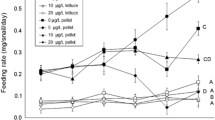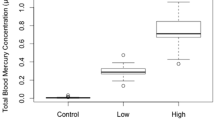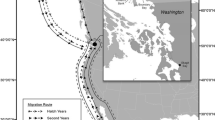Abstract
The purpose of this experiment was to use mallards (Anas platyrhynchos) tested under controlled conditions to determine how much harm to reproduction resulted from various concentrations of mercury in eggs. Breeding pairs of mallards were fed a control diet or diets containing 1, 2, 4, or 8 μg/g mercury, as methylmercury chloride. Mean concentrations of mercury in eggs laid by parents fed 0, 1, 2, 4, or 8 μg/g mercury were 0.0, 1.6, 3.7, 5.9, and 14 μg/g mercury on a wet-weight basis. There were no signs of mercury poisoning in the adults, and fertility and hatching success of eggs were not affected by mercury. Survival of ducklings and the number of ducklings produced per female were reduced by the 4 and 8-μg/g dietary mercury treatments (that resulted in 5.9 and 14 μg/g mercury in their eggs, respectively). Ducklings from parents fed the various mercury diets were just as heavy as controls at hatching, but by 6 days of age ducklings whose parents had been fed 4 or 8 μg/g mercury weighed less than controls. Because we do not know if absorption of mercury from our diets would be the same as absorption from natural foods, the mercury concentrations we report in eggs may be more useful in extrapolating to possible harmful effects in nature than are the dietary levels we fed. We conclude that mallard reproduction does not appear to be particularly sensitive to methylmercury.

Similar content being viewed by others
References
Albers PH, Koterba MT, Rossmann R, Link WA, French JB, Bennett RS, Bauer WC (2007) Effects of methylmercury on reproduction in American kestrels. Environ Toxicol Chem 26:1856–1866
Alpers CN, Hujnerlach MP (2000) Mercury contamination from historic gold mining in California. U.S. Geological Survey Fact Sheet FS-061-00, Sacramento, CA
Borg K, Wanntorp H, Erne K, Hanko E (1969) Alkyl mercury poisoning in terrestrial Swedish wildlife. Viltrevy 6:301–379
Burgess NM, Meyer MW (2008) Methylmercury exposure associated with reduced productivity in common loons. Ecotoxicology 17:83–91
Evers DC, Savoy LJ, DeSorbo CR, Yates DE, Hanson W, Taylor KM, Siegel LS, Cooley JH Jr, Bank MS, Major A, Munney K, Mower BF, Vogel HS, Schoch N, Pokras M, Goodale MW, Fair J (2008) Adverse effects from environmental mercury loads on breeding common loons. Ecotoxicology 17:69–81
Fimreite N (1971) Effects of dietary methylmercury on ring-necked pheasants. Occasional Paper No. 9. Canadian Wildlife Service, Ottawa, Canada
Fimreite N (1974) Mercury contamination of aquatic birds in Northwestern Ontario. J Wildl Manage 38:120–131
Finley MT, Stendell RC (1978) Survival and reproductive success of black ducks fed methyl mercury. Environ Pollut 16:51–64
Gardiner EE, Hironaka R, Slen SB (1971) Growth, feed efficiency and levels of mercury in tissues of two breeds of chickens fed methyl mercury dicyandiamide. Can J Anim Sci 51:657–662
Heinz G (1974) Effects of low dietary levels of methylmercury on mallard reproduction. Bull Environ Contam Toxicol 11:386–392
Heinz GH (1979) Methylmercury: reproductive and behavioral effects on three generations of mallard ducks. J Wildl Manage 43:394–401
Heinz GH (1996) Mercury poisoning in wildlife. In: Fairbrother A, Locke LN, Hoff GL (eds) Noninfectious diseases of wildlife, 2nd edn. Iowa State University Press, Ames, IA, USA, pp 118–127
Heinz GH, Hoffman DJ (1998) Methylmercury chloride and selenomethionine interactions on health and reproduction in mallards. Environ Toxicol Chem 17:139–145
Heinz GH, Hoffman DJ (2003) Embryotoxic thresholds of mercury: estimates from individual mallard eggs. Arch Environ Contam Toxicol 44:257–264
Heinz GH, Hoffman DJ (2004) Mercury accumulation and loss in mallard eggs. Environ Toxicol Chem 23:222–224
Heinz GH, Hoffman DJ, Klimstra JD, Stebbins KR, Kondrad SL, Erwin CA (2009a) Species differences in sensitivity of avian embryos to methylmercury. Arch Environ Contam Toxicol 56:129–138
Heinz GH, Hoffman DJ, Klimstra JD, Stebbins KR (2009b) Rapid increases in mercury concentrations in the eggs of mallards fed methylmercury. Environ Toxicol Chem 28:1979–1981
Heinz GH, Hoffman DJ, Klimstra JD, Stebbins KR (2010) Enhanced reproduction in mallards fed a low level of methylmercury: an apparent case of hormesis. Environ Toxicol Chem 29:650–653
Henny CJ, Hill EF, Grove RA, Kaiser JL (2007) Mercury and drought along the lower Carson River, Nevada: snowy egret and black-crowned night-heron annual exposure to mercury, 1997–2006. Arch Environ Contam Toxicol 53:269–280
Hill EF, Henny CJ, Grove RA (2008) Mercury and drought along the lower Carson River, Nevada: II. Snowy egret and black-crowned night-heron reproduction on Lahontan Reservoir, 1997–2006. Ecotoxicology 17:117–131
Meyer MW, Evers DC, Hartigan JJ, Rasmussen PS (1998) Patterns of common loon (Gavia immer) mercury exposure, reproduction, and survival in Wisconsin, USA. Environ Toxicol Chem 17:184–190
Scheuhammer AM, Meyer MW, Sandheinrich MB, Murray MW (2007) Effects of environmental methylmercury on the health of wild birds, mammals, and fish. Ambio 36:12–18
Schwarzbach SE, Albertson JD, Thomas CM (2006) Effects of predation, flooding, and contamination on reproductive success of California Clapper rails (Rallus longirostris obsoletus) in San Francisco Bay. Auk 123:45–60
Spalding MG, Bjork RD, Powell GVN, Sundlof SF (1994) Mercury and cause of death in great white herons. J Wildl Manage 58:735–739
Tejning S (1967) Biological effects of methyl mercury dicyandiamide-treated grain in the domestic fowl Gallus gallus L. Oikos 8:1–116
Thompson DR (1996) Mercury in birds and terrestrial mammals. In: Beyer WN, Heinz GH, Redmon-Norwood AW (eds) Environmental contaminants in wildlife: interpreting tissue concentrations. CRC Press, Boca Raton, FL, USA, pp 341–356
U. S. EPA (2000) Method 7473, Mercury in solids and solutions by thermal decomposition, amalgamation, and atomic absorption spectrophotometry, Test methods for evaluating solid waste, physical/chemical methods SW 846, Update IVA. U.S. Government Printing Office (GPO), Washington, DC, U.S.A
U. S. EPA (2005) US EPA National Fish and Wildlife Contamination Program, Fish Consumption Advisories (http://www.epa.gov/waterscience/fish/advisories/2004/maps)
Wiener JG, Krabbenhoft DP, Heinz GH, Scheuhammer AM (2003) Ecotoxicology of mercury. In: Hoffman DJ, Rattner BA, Burton GH Jr, Cairns J Jr (eds) Handbook of ecotoxicology, 2nd edn. CRC, Boca Raton, FL, USA, pp 409–463
Acknowledgments
This research was funded by the CALFED Bay-Delta Program’s Ecosystem Restoration Program (grant number ERP-02D-C12) with additional support from the USGS Patuxent Wildlife Research Center. We thank Barnett Rattner and Oliver Pattee for reviewing an earlier draft of this manuscript.
Author information
Authors and Affiliations
Corresponding author
Rights and permissions
About this article
Cite this article
Heinz, G.H., Hoffman, D.J., Klimstra, J.D. et al. Reproduction in mallards exposed to dietary concentrations of methylmercury. Ecotoxicology 19, 977–982 (2010). https://doi.org/10.1007/s10646-010-0479-y
Accepted:
Published:
Issue Date:
DOI: https://doi.org/10.1007/s10646-010-0479-y




